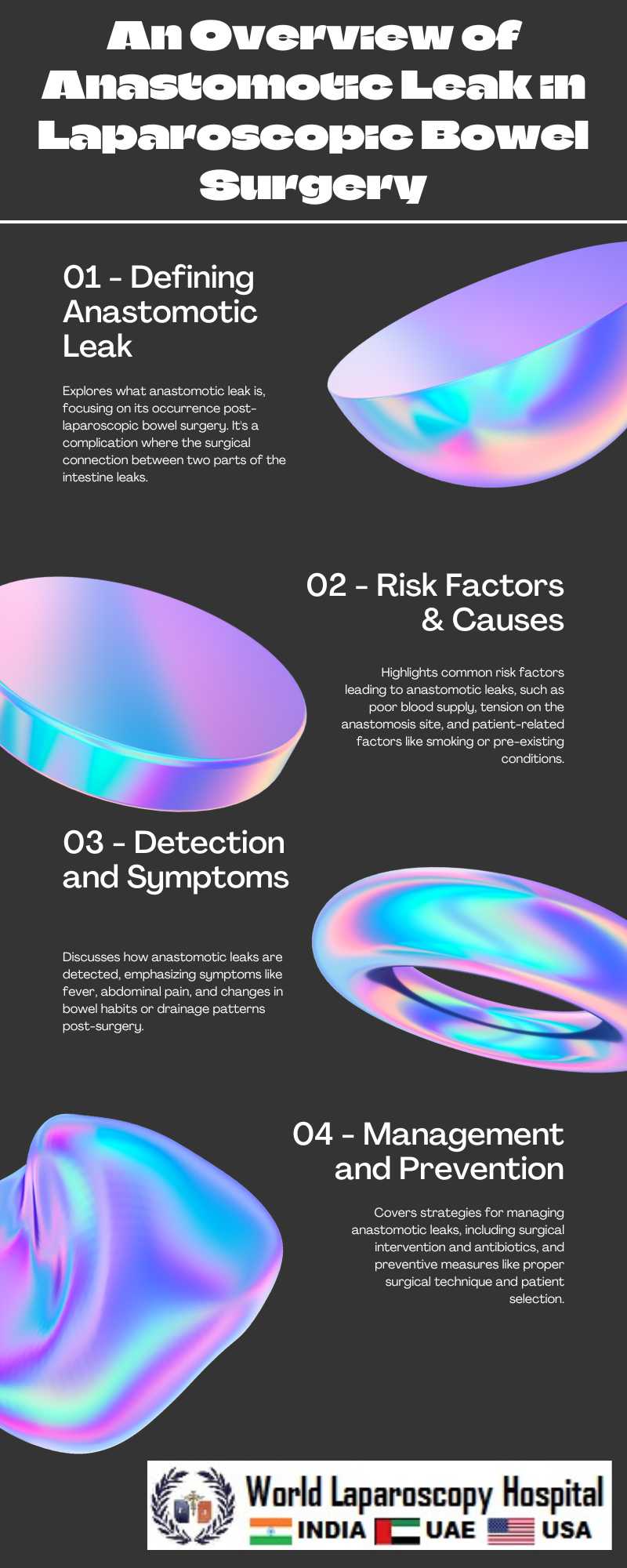An Overview of Anastomotic Leak in Laparoscopic Bowel Surgery
Anastomotic leak is a significant and potentially severe complication in laparoscopic bowel surgery. This essay provides an overview of this condition, discussing its definition, incidence, risk factors, diagnosis, management, and the implications on surgical outcomes.
Definition and Incidence
Anastomotic leak refers to a breakdown in the integrity of the surgical join between two segments of the bowel. This complication is particularly concerning in laparoscopic bowel surgery due to the minimally invasive nature of the procedure. The incidence of anastomotic leaks varies widely in literature, generally reported between 1% and 19%, depending on the type of surgery, patient population, and the definition of leak used.

Risk Factors
Several factors contribute to the risk of anastomotic leaks. These can be patient-related, such as age, nutritional status, presence of comorbidities like diabetes, or smoking history. Surgical factors include the technique used, the experience of the surgeon, the type of anastomosis, and intraoperative complications. Emergent surgeries, such as those for bowel obstruction or perforation, carry a higher risk compared to elective procedures.
Diagnosis
Early diagnosis of anastomotic leaks is crucial for patient outcomes but remains challenging. Clinical signs can be subtle and nonspecific, including fever, abdominal pain, or changes in drainage fluid. Radiological investigations, such as a CT scan with oral and IV contrast, are often employed for diagnosis. In some cases, a diagnostic laparoscopy may be necessary.
Management
Management strategies for anastomotic leaks depend on the severity and clinical presentation. Conservative management includes antibiotics, bowel rest, and nutritional support. Interventional radiology can be employed for percutaneous drainage of abscesses. In severe cases, surgical intervention may be necessary, which could involve resection of the anastomosis, creation of a stoma, or extensive peritoneal lavage.
Implications on Surgical Outcomes
Anastomotic leaks significantly impact surgical outcomes. They are associated with prolonged hospital stays, increased morbidity, higher rates of readmission, and increased mortality. Moreover, leaks can have long-term consequences, such as chronic sepsis, fistula formation, and the need for complex reoperations.
Conclusion
In conclusion, anastomotic leak remains a significant challenge in laparoscopic bowel surgery. Its management requires a high index of suspicion, rapid diagnosis, and appropriate intervention. Surgeons must be cognizant of the risk factors and employ strategies to minimize the risk, such as meticulous surgical technique and careful patient selection. Ongoing research and advancements in surgical techniques and postoperative care are essential to further reduce the incidence and impact of this complication.
Definition and Incidence
Anastomotic leak refers to a breakdown in the integrity of the surgical join between two segments of the bowel. This complication is particularly concerning in laparoscopic bowel surgery due to the minimally invasive nature of the procedure. The incidence of anastomotic leaks varies widely in literature, generally reported between 1% and 19%, depending on the type of surgery, patient population, and the definition of leak used.

Risk Factors
Several factors contribute to the risk of anastomotic leaks. These can be patient-related, such as age, nutritional status, presence of comorbidities like diabetes, or smoking history. Surgical factors include the technique used, the experience of the surgeon, the type of anastomosis, and intraoperative complications. Emergent surgeries, such as those for bowel obstruction or perforation, carry a higher risk compared to elective procedures.
Diagnosis
Early diagnosis of anastomotic leaks is crucial for patient outcomes but remains challenging. Clinical signs can be subtle and nonspecific, including fever, abdominal pain, or changes in drainage fluid. Radiological investigations, such as a CT scan with oral and IV contrast, are often employed for diagnosis. In some cases, a diagnostic laparoscopy may be necessary.
Management
Management strategies for anastomotic leaks depend on the severity and clinical presentation. Conservative management includes antibiotics, bowel rest, and nutritional support. Interventional radiology can be employed for percutaneous drainage of abscesses. In severe cases, surgical intervention may be necessary, which could involve resection of the anastomosis, creation of a stoma, or extensive peritoneal lavage.
Implications on Surgical Outcomes
Anastomotic leaks significantly impact surgical outcomes. They are associated with prolonged hospital stays, increased morbidity, higher rates of readmission, and increased mortality. Moreover, leaks can have long-term consequences, such as chronic sepsis, fistula formation, and the need for complex reoperations.
Conclusion
In conclusion, anastomotic leak remains a significant challenge in laparoscopic bowel surgery. Its management requires a high index of suspicion, rapid diagnosis, and appropriate intervention. Surgeons must be cognizant of the risk factors and employ strategies to minimize the risk, such as meticulous surgical technique and careful patient selection. Ongoing research and advancements in surgical techniques and postoperative care are essential to further reduce the incidence and impact of this complication.
2 COMMENTS
Dr. Nicole Bohm
#1
Jan 27th, 2024 9:27 am
Anastomotic leak, a breakdown in bowel surgical join integrity, raises concerns, especially in laparoscopic bowel surgery. Incidence varies (1-19%) based on surgery type, patient demographics, and leak definition.
Dr. Ketan Sharma
#2
Feb 16th, 2024 10:20 am
Anastomotic leak poses a formidable challenge in laparoscopic bowel surgery. Vigilant diagnosis and intervention are crucial, demanding meticulous technique and risk mitigation strategies. Ongoing research and advancements are key to mitigating this complication's incidence and impact effectively.
| Older Post | Home | Newer Post |





